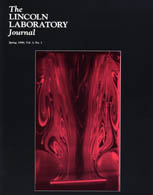Publications
Volume 3, Number 1
 |
|
A New Organometallic Vapor Phase Epitaxy Reactor for Highly Uniform Epitaxy We have designed and built a new organometallic vapor phase epitaxy (OMVPE) reactor for the growth of thin films of compound semiconductors such as GaAs and AlGaAs. The reactor grows highly uniform and reproducible epitaxial layers that can be fabricated into various electronic and optoelectronic devices. To obtain such precision, we designed the reactor by using both gas-flow visualization and numerical modeling. The design results in uniform laminar flow and short gas residence times, which are critical for obtaining uniform growth and abrupt interfaces between epitaxial layers over large surface areas. High-performance quantum-well diode lasers designed to pump solid state lasers have been fabricated from such uniform layers. Near-Field Testing of Adaptive Radar Systems Large phased-array antennas with multiple displaced phase centers are applied to radar applications that require adaptive suppression of jamming and clutter. Before the deployment of this adaptive radar, tests must verify how well the system detects targets and suppresses clutter and jammer signals. This article discusses a recently developed focused near-field testing technique that is suitable for implementation in an anechoic chamber. With this technique, phased-array near-field focusing provides far-field equivalent performance at a range distance of one aperture diameter from the adaptive antenna under test. The technique is applied theoretically to a dual-phase-center sidelobe-canceler antenna with multiple near-field sources within the main beam and sidelobes. Numerical simulations indicate that near-field and far-field testing can be equivalent. Speech Recognition Using Hidden Markov Models The Lincoln robust hidden Markov model speech recognizer currently provides state-of-the-art performance for both speaker-dependent and speaker-independent large-vocabulary continuous-speech recognition. An early isolated-word version similarly improved the state of the art on a speaker-stress-robustness isolated-word task. This article combines hidden Markov model and speech recognition tutorials with a description of the above recognition systems. Estimating the Fractal Dimension of Chaotic Time Series Fractals arise from a variety of sources: they have been observed in nature and on computer screens. An intriguing characteristic of fractals is that they can be described by noninteger dimensions. The geometry of fractals and the mathematics of fractal dimension provide useful tools for a variety of scientific disciplines—in particular, the study of chaos. A chaotic dynamical system exhibits trajectories that converge to a strange attractor. The fractal dimension of this attractor counts the effective number of degrees of freedom in the dynamical system and thus quantifies the system's complexity. This article reviews the numerical methods that have been developed to estimate the dimension of a physical system directly from the system's observed behavior. Range-Doppler Imaging with a Laser Radar The design of imaging waveforms for a heterodyne-detection range-Doppler laser radar depends on target dynamics as well as hardware constraints. This article describes the electric fields of the signals, the optimal form of the receiver, and the signal processing issues associated with range-Doppler imaging. The performance of unmodulated pulse trains, linear-frequency-modulated (LFM) chirp pulse trains, and biphase shift-keyed (BPSK) pulse trains as imaging waveforms is addressed. Two methods of coherent imaging are developed: one method is suitable for periodic pulse trains and the other method is a more generalized approach. Relationships between the target spin rate and the waveform parameters for unambiguous range-Doppler imaging are presented; the radar ambiguity function establishes a relative performance comparison of the waveform types. Two receiver block diagrams are presented: one specifically for processing the LFM chirp pulse train waveform and another more generalized processor for a wide variety of pulse train waveforms. Receiver signal processing issues and trade-offs, including range-Doppler coupling and waveform amplitude weighting for reduced range and Doppler sidelobes, are discussed. Firepond indoor test-range images illustrate the beneficial effects of zero padding and incoherent averaging. Finally, we present a scheme that compensates for amplitude errors and phase errors, and results in dramatically improved image quality. A Radar for Unmanned Air Vehicles Over the years airborne radars have proven their value as wide-area, nearly all-weather surveillance tools. Typically, airborne radars are large systems mounted in manned aircraft. Lincoln Laboratory, however, has built a very capable radar system that is compact and lightweight; the radar has been integrated into an unmanned air vehicle (UAV). The work is sponsored by the Army's Harry Diamond Laboratories and the Defense Advanced Research Projects Agency (DARPA). A significant component of the radar is a Lincoln Laboratory-designed programmable processor that performs moving-target detection on board the UAV. The onboard processing permits the use of a UAV data link that transmits kilobits per second of moving-target reports instead of tens of megabits per second of raw radar data. The system—the airborne portion of which weighs only 110 lb—detects and tracks moving vehicles such as tanks, trucks, and low-flying helicopters out to a range of 15 km, and classifies them at shorter ranges. |
|